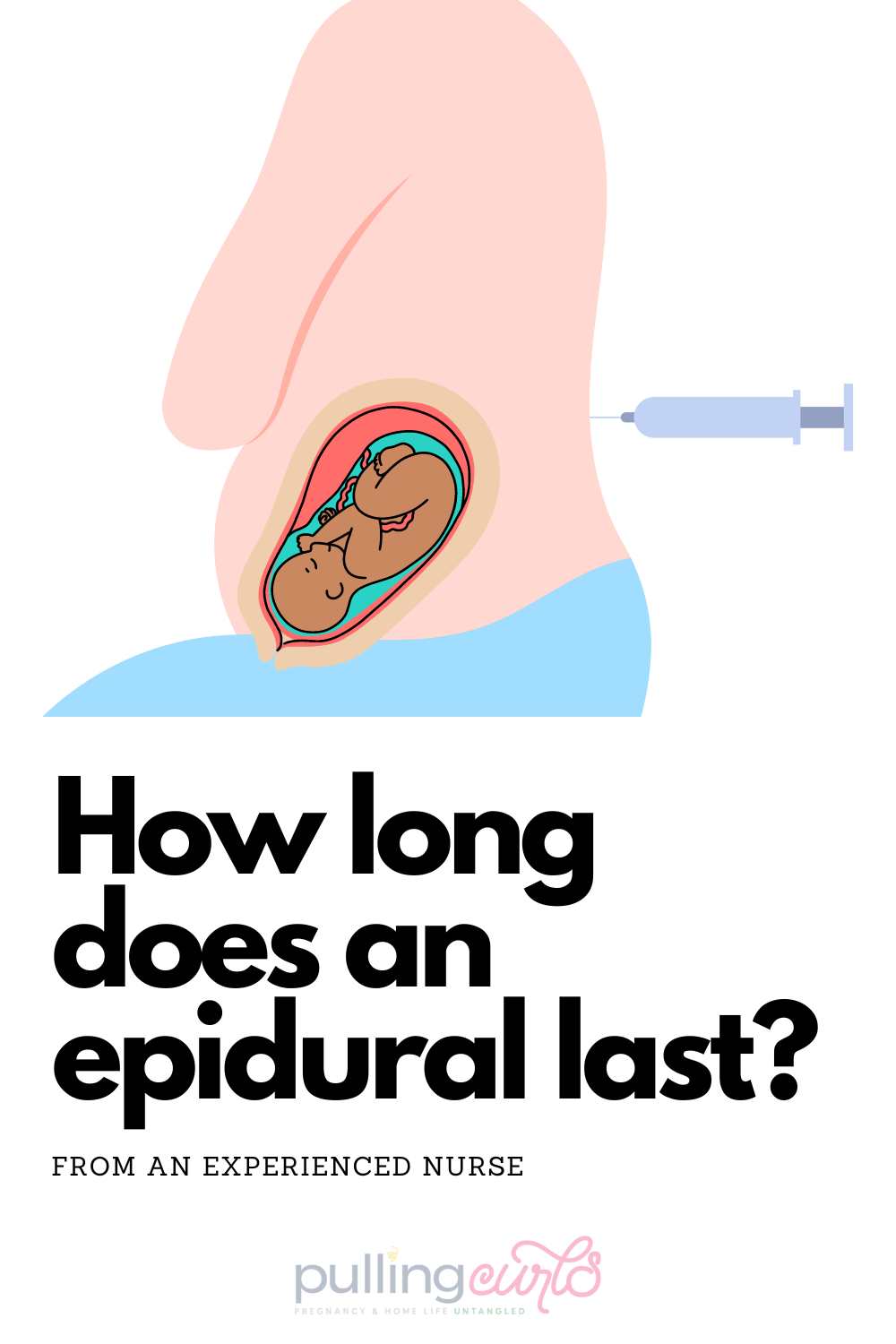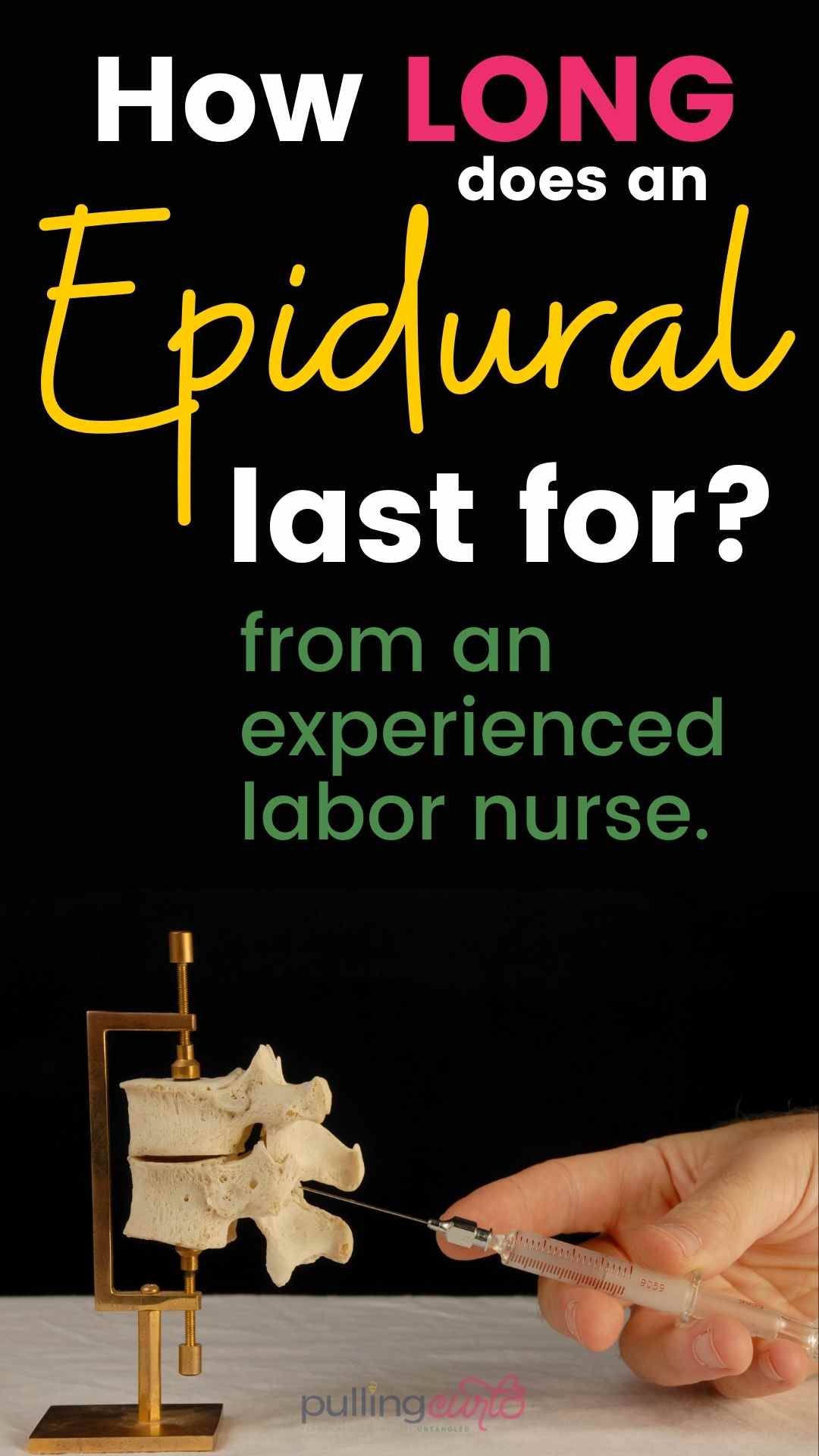How long can you expect your epidural to last? Will it wear off, and how long does it last (and when will you be able to walk again???). These are all super common questions you have beofore labor and this post (written by an experienced L&D nurse) will answer all of them for you.

But, how do I know so much about epidurals?
First off, hello! I’m Hilary — many people know me as The Pregnancy Nurse 👩⚕️. I have been a nurse since 1997 and I have 20 years of OB nursing experience, I am also the curly head behind this website Pulling Curls and The Online Prenatal Class for Couples. 🩺 I have helped put in thousands of epidurals, along with having several of my own, and I’m happy to share my knowledge with you.
Grab my pain management options information here:
Quick tip: There are LOTS of types of epidurals. This article is going to focus on LABOR epidurals. If you’re looking on information on an epidural steroid injection you’ll want to look elsewhere (those are more often given for leg pain, back issues like a herniated disc, spinal stenosis etc).
Ok, let’s address the big question:
How long does epidural last?
It really lasts as long as we need it to. Best practice now is to place the epidural and infuse medication into it that helps numb those signals to the lower part of your body until we turn it off.
While there can be issues that arise that would stop it from doing that, that is our plan. I have seen epidurals last days, although our hope is that your labor is less than that.
But, it’s more complicated than that, so let’s keep talking.
What is an Epidural?
Some of you may want to entirely ignore this one, but it’s SO important to understand really what it is and what it can –and can not — do for you, so read this part!
Remember, epidurals come in many forms. While we’re speaking to a labor epidural, a very similar process is also used to help other types of pain as well!
Epidurals are regional anesthesia (meaning it only numbs a portion of your body instead of putting you to sleep, or local anesthetic that only does a small area). Medicine is pushed in the epidural space (hence, the name) of your spinal column.
It is aimed to numb spinal nerves while help control pain (including labor, surgical pain, and chronic pain). Most often it is given sitting up, and your medical team will help position you for it.
Epidurals are most often given by a nurse anesthetist or an anesthesiologist — your pain management specialist.
Each of those will last for a different period of time, and are for pain management — but today we’re talking labor epidurals — how they work to numb the pain of contractions.
And yes, epidurals can seem really complicated, but I aim to really simplify them in here.
How is an epidural placed?
In most cases, an epidural is initially placed after about 3-6 cm of dilation (this post>> can tell you all about epidural placement, including how long the epidural needle is — and this post tells if an epidural hurts).
Are you afraid of the epidural or the pain of labor I recommend The Online Prenatal Class for Couples — it will prepare you for pain, and how you can manage it. I actually have a video where I place an epidural using Raggedy Anne.
Initially, they will numb the injection site. And then they find the epidural space (using an epidural needle).
After that, they will feed in an epidural catheter (a tube — it’s just about the side of spaghetti noodle, and is flexible) that will hang-out in your back until you’ve had the baby — and that replaces the needle.
That little tube (called an epidural catheter) will carry the medicine into your epidural space (which is not the same space your spinal cord is in) until we stop it or it gets pulled out. It’s sort of like an IV in your back.
Some doctors do a combined spinal-epidural (CSE) that helps if you’re in a lot of pain when the epidural is placed. Which type of anesthesia they give you is based on the doctor’s preference (and abilities).
The doctor then gives you a large amount of epidural medication into that space — we call that a “bolus”.
The medicine is pushed in via a small tube in your back through a pump — very similar to how your IV goes into your arm. This makes it a very reliable method of pain control. The actual pain medication given in the epidural space does NOT last a long time, but we pump in new medication until we turn it off.
The amount of medication (and type), and how much pain relief you get is up to the doctor, for the most part. However, you need to speak up if you’re still feeling more than you’d prefer (remember they still want you to feel some — probably take away 80% of the pain).
Where does an epidural go?
To you, it will just seem like your lower back — similarly line as the top of your hip bones (but in the center of your back).
But, anesthesiologists place it between two of the membranes that cover your spinal canal (this is called the epidural space). It’s kind of like putting a needle into a banana and injecting between the peel and the fruit. That’s why it’s so important that you hold still so that they can do that very technical work.
How quickly does the epidural work during labor?
Most people have it take full effect by about 20-30 minutes after the complete placement (there is a good amount of set-up time after the provider enters the room). At this point it’s called an epidural nerve block as it’s blocking those nerves from giving you as much information about the pain in your lower half.
From there, the plan is for an epidural to last until we stop it, making for a positive birth experience.
That can go awry with things like the tube coming out of the right spot, or it gets kinked, but in most situations, it lasts until we stop it.
Can an Epidural “Wear Off”?
“Back in the day”, doctors used to just come in and give a giant amount of medicine every few hours (that’s how it worked when I had my first baby in 2000). It didn’t drip into your back — but I would guess that all hospitals have it going in via a pump while you’re in labor.
This is one of those things that might be VERY different than when your mom had a baby. Make sure you take a class to be up to date on what to expect.
Causes of the Epidural “Wearing Off” During Labor:
There are things that stop the medicine getting to you though, and if you’re starting to feel pain your nurse and anesthesia provider can check:
- Is the pump still on and working (and not out of medicine — although the pump beeps like crazy once it’s out of medicine)
- Is the tube kinked — also pretty rare, this tube is firmer than regular IV tubes
- Has the tube moved out of the right spot in your back?
- Do you need more medication? They can give you more all at once, or increase the dosage on the pump.
Sometimes they can troubleshoot it with those things (often pulling the tube out a bit and re-taping it fixes it) but sometimes they do have to place a new epidural.
What You Can Do to Make the Epidural Last:
There are a few things you can do (and your providers will discuss all of this with you at the time):
Stay really still when they place it (that part is actually not very long, so it’s only a few minutes where you have to stay completely still) to make sure it’s just in the right spot.
Try not to drag your back across your bed when you move. Your provider will be a huge amount of tape around the epidural site, and we want you to feel comfortable moving your back (remember, the needle is removed once they get the tube in that spot). Just try not to drag it across the bed. Lifting it and moving place to place is better.
This all being said it’s not the worst thing in the world to have replace it. Most people say that the epidural placement is not as painful as the IV, and they do numb the spot well before placing it.
Can I get extra medicine if I need it?
Most pumps have a button that you can push for an extra amount of medication. The pump is set to only allow you a certain amount of medication each hour.
If you are in a lot of pain, it is important you let your nurse/provider know so they can assess if you’re progressing or what is up.
Your anesthesiologist can also come in and give more/different medication if the medicine going in via the pump isn’t enough. He can also turn the rate that the medicine goes into your back either up or down depending on if you’re feeling too much or too little.
**Sometimes we will turn off, or lower the rate for your epidural once it’s time to push so that you’re able to feel more. However, we can titrate it to make sure you still don’t feel a lot of pain when baby is coming out.
How often can you push epidural button?
Most places lock you out for about 20 minutes. So, even if you keep pushing the button, it will only deliver a dose every 20 minutes. This is to prevent you from giving yourself too much medication. An important safety feature.
Pro Tip: I WANT to know if my patients are in pain with an epidural so I can troubleshoot it. so, if you’re feeling like you need to push the button really often please do let you nurse know so we can troubleshoot it!
Can you still feel pain after epidural?
Epidurals are meant to take away 80% of the pain. Also, as baby descends into the birth canal that is pressure not pain — and the epidural will not entirely take that away. That can be uncomfortable.
Most people are very happy with a good epidural, but if you are still feeling more pain than you would like, talk with your team.
Remember it is important that you can still feel that pressure, and move your body with some assistance to help labor along. Hence, we aim for 80%.
I have a whole post on how much pain you’ll feel with an epidural.
Are there side effects to the epidural medicine?
Common side effects of the epidural anesthesia can be itching, a mild increase in temperature and clearly — numbness/inability to move their lower extremities as well as before.
There are other potential side effects (that are VERY rare) — and your provider may review them with you before the procedure.
Keep in mind that the MOST common side effect is your blood pressure dropping (which is why we give you a lot of fluids in advance), and that does NOT last long (as your body becomes used to the epidural medications and it not being in pain any longer).
You can also get a severe headache if the epidural block goes a bit far into the spinal fluid. This type of headache is very apparent and your provider can fix it with a blood patch. There are a few other rare complications and some serious complications your provider should go over with you before getting it.
If you’re on blood thinners there can be an increased risk, and other medical conditions can be problematic as well.
Keep in mind that the epidural is done in a separate spot than the actual nerves. So the risk of nerve damage is VERY small. Many women complain of lower back pain after having a baby (but it’s hard to separate that from the pain you might have from all your new tasks, the car seat, feeding etc.
** Your doctor should do informed consent explaining the risks and benefits to the procedure before placing the epidural.
Btw, if you’d like you thank your nurse, I have a whole post on gifts for labor and delivery nurses.
How long can you have an epidural?
In general, you could have an epidural for quite a long time. It can infuse for days (I’ve never gotten to the point that we had to replace it), but it is best not to….
In general, we don’t want people in hard labor (hard enough to get an epidural) for more than a day…. Although it does happen.
There may be hospital policies (likely due to infection rates) that an epidural can only be in for a certain number of hours and then must be replaced. But, because an epidural is followed closely by either a doctor or a nurse anesthetist (and done sterile-y) this shouldn’t be too much of an issue.
If you have any questions about that you can always ask your nurse about your particular hospital (I’ve never had one of those policies at my work).
How long does it take for epidural to wear off?
The epidural usually takes 1-2 hours to wear off after we turn-off the medication and/or remove the tubing from your back.
Most often we turn it off after the doctor has the placenta out and is done with any repair needed, and we remove it once you’re in a position to have it removed (I don’t want to interrupt skin to skin to remove it if possible).
Your legs may still feel a bit weird that first time you get it. Make sure you hold onto your nurse and take her help the first time you get up. All of that is totally normal!
How long does an epidural last after a C-section
Most planned C-sections have a spinal, although if you have an in-dwelling epidural they may put in a lot of medicine to get that to work the same way.
Those epidurals will wear off slowly — and last to their full effect about 2 hours (where you can’t move your legs at all). It slowly wears off after about 2 hours — sort of moving up your body. Your abdomen will have the epidural last the longest, so that’s a total perk of spinal or epidural anesthesia vs general anesthesia.
We usually leave the urine catheter in for 6-12 hours after the surgery and we often will sit you on the side of the bed when that comes out. Prior to then it would be really hard to get up and walk as the spinal is still wearing off.
I also have a post on what to take to the hospital for your C-section.
What should you not do after an epidural?
Other epidurals that aren’t for labor have specific recommendations for what to do (or not do) afterwards. But, because you just had a baby most of those rules already apply. No heavy lifting, and try to get plenty of rest — all of which will just happen after you have your baby in the hospital.
Unless something really rare happened, no special precautions are given if you had an epidural in the hospital. You’ll go home just like someone who had a “natural” birth.
Which is better — epidural or natural birth?
Every woman and every labor is so different. Never has this advice been more pertinent — you do you. Do what works for you. You can’t compare your labor or your pain with anyone else’s. After almost 20 years in L&D I can guarantee you that.
BUT, let’s answer this one that gets a lot of questions:
When should I get my epidural so that it doesn’t wear off before I have my baby?
Hopefully, you understand that it should last through labor if done properly, and nothing messes it up. I do have the answer to when I think you should get it right here:
Most often we recommend you not get it until you’re well into active labor (I go over the phases of labor in this post)
So, that’s that — in general, you don’t need to worry about the epidural wearing off before you have your baby — but remember — an epidural isn’t meant to take away ALL labor pain << read that post to find out why.
AND if you’re interested in more info on pain management during delivery be sure to check out my Online Prenatal Class for Couples.
- Accurate — you’ll get the RIGHT info. Since I still deliver I really know what I’m talking about
- Engaging — so many couples call it “fun” — which I love!
- Budget-Friendly — pick the price point that works for you, it’s the best-priced class online!
Have you checked a birth class off your to do list✅? I have a few I recommend:
❤️ Best class for couples {per BabyList}
👩💻 Best class available on demand
⚡ Best class JUST for pain management
👶 Best Postpartum-Only Prep
❤️🧡💛💚💙💜 My favorite class is here.
Now is the time to get started!
Or, if you’re not quite ready for the full class, check out my free prenatal class — It’s your first step towards being your own birth boss.
















Leave a Reply